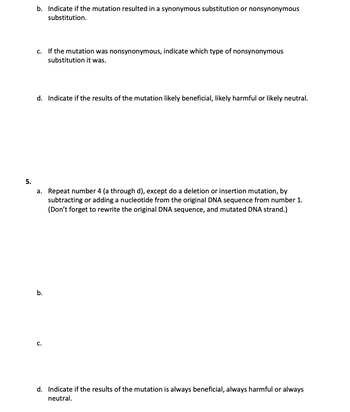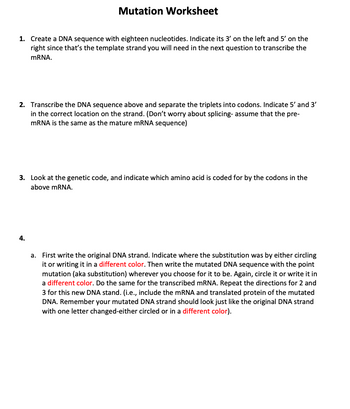
1. Create a DNA sequence with eighteen nucleotides. Indicate its 3’ on the left and 5’ on the right since that’s the template strand you will need in the next question to transcribe the mRNA.
2. Transcribe the DNA sequence above and separate the triplets into codons. Indicate 5’ and 3’ in the correct location on the strand. (Don’t worry about splicing- assume that the pre- mRNA is the same as the mature mRNA sequence)
3. Look at the genetic code, and indicate which amino acid is coded for by the codons in the above mRNA.
4. ANSWER BELOW QUESTIONS:
A. First write the original DNA strand. Indicate where the substitution was by either circling it or writing it in a different color. Then write the mutated DNA sequence with the point mutation (aka substitution) wherever you choose for it to be. Again, circle it or write it in a different color. Do the same for the transcribed mRNA. Repeat the directions for 2 and 3 for this new DNA stand. (i.e., include the mRNA and translated protein of the mutated DNA. Remember your mutated DNA strand should look just like the original DNA strand with one letter changed-either circled or in a different color).
B. Indicate if the mutation resulted in a synonymous substitution or nonsynonymous substitution.
C. If the mutation was nonsynonymous, indicate which type of nonsynonymous substitution it was.
D. Indicate if the results of the mutation likely beneficial, likely harmful or likely neutral.
5. ANSWER BELOW QUESTIONS:
A. Repeat number 4 (a through d), except do a deletion or insertion mutation, by subtracting or adding a
B.
C.
D. Indicate if the results of the mutation is always beneficial, always harmful or always neutral.


Step by stepSolved in 2 steps

- 2. How many codons are there in the mRNA?arrow_forward1. Given the DNA sequence below: 5’-ACATGTGTACAGGCTTTGTCTGAATGGCTT-3’ 3’-TGTACACATGTCCGAAACAGACTTACCGAA-5’ Translate the mRNA. (Using the 3-letter code for amino acids, write the primary structure of the peptide that will be produced.) 2. Given the DNA sequence below: 5’-ACATGTGTACAGGCTTTGTCTGAATGGCTT-3’ 3’-TGTACACATGTCCGAAACAGACTTACCGAA-5’ Translate the mRNA. (Using the 3-letter code for amino acids, write the primary structure of the peptide that will be produced.)arrow_forward6. Similar to the class notes (Intro to Genetics), a segment of DNA (shown below) contains a promoter segment (the first 9 base pairs), a ribosome binding segment (the next 6 base pairs), and a segment that codes for protein synthesis which is started by the rest of the base pairs. ACTCCATTGAACCATTTCTATGATCCGCTAACG-... TGAGGTAACTTGGTAAAGATACTAGGCGATTGC-... A. When the DNA is induced to be copied to mRNA, the top strand is coding, meaning that the mRNA makes an identical copy of the lower strand (replacing T with U) The mRNA copy starts with the ribosome binding sequence. What is the sequence of the mRNA that will go to the ribosomes? B. What are the first 6 amino acids of the protein that are coded for by the mRNA? C. What would the amino acid sequence be if... i. a transition mutation occurred on the final G in the mRNA? ii. all of the G & C bases in the protein synthesis portion had transition mutations? iii. a point deletion mutation occurred in the ATA sequence (in the lower strand…arrow_forward
- Choose the correct sequence for Translation process. 1. Translocation of the large subunit 2. Formation of peptide bond 3. Translocation of the small subunit 4. TRNA binding O4,1,2,3 O 2,4,3,1 O4,2,1,3 O 1,2,3,4arrow_forwardCan you help me with this question?arrow_forward36.Start with two exons and an intervening intron. Include the cap and poly-A tail in your starting pre-mRNA. Show 2’-OH, 3’-OH, O-P-O phosphodiester bonds for the two transesterification reactions that splice exon 1 and exon 2. Be sure to include the branchpoint A and intron consensus sequences. You will need to show where the incoming -OH attacks the O-P-O bond to allow correct splicing in the lariat and between exons. Make your arrows precise. Show the lariat with the consensus sequences. Whenever possible, show 5’ and 3’ ends. Explain the fate of the lariat after it forms?arrow_forward
- If DNA segments changes from GCATAG to GCATA, this is a: MRNA Codon/Amino Acid Chart First Base Second Base Third Base U A G 0001 Phenylalanine UCU UAU1 Tyrosine (Tyr) UAC UGUT FCcysteine (Cys) UGCJ U UUCJ (Phe) UCC Serine (Ser) UCA U UUA1 UAAT UGA - Stop A FLeucine (Leu) UUG- FStop UAG- UCG- UGG - Tryptophan (Trp) G CU- CCU CGUT CAU1 Histidine (His) CAC U CUC FLeucine (Leu) CUA CC Proline (Pro) CCA CGC FArginine (Arg) CGA CAA1 Glutamine A CAGI (Glu) CGG- CUG- CCG- G AUU AAU1 Asparagine ACU1 AGUT FSerine (Ser) AGC- AUC FIsoleucine (le) ACC Threonir AACJ (Asn) A AUA- ACA (Thr) AAA1 FLysine (Lys) AAG- AGA, FArginine (Arg) AGG- A Start Methionine (Met) ACG- AUG - GUU- GCU GAU- GGU | Aspartic Acid GAÇJ(Asp) U GỤC Valine (Val) GUA GCC FAlanine (Ala) GGC Glycine (Gly) GGA G GAA1 Glutamic Acid A GCA GCG- GAGJ (Glu) GGG- GUG- Garrow_forward5’ AUG UUA CGU AAU GCU GUC GAA UCU AUU UGC UUU ACA UAA 3' Write the sequence of the DNA template (antisense) strand from which the mRNA was synthesized. Write the sequence of the DNA coding (sense or informational) strand complementary to the template strand. Write the sequence of tRNA anticodon that corresponds to the given mRNA molecule. Write the amino acid sequence of the peptide synthesized from the given mRNA nucleotide sequence.arrow_forwardUse this mRNA coding sequence as your starting point. This sequence begins with a start codon and ends with a stop codon, so it is only looking at the region of DNA that directly encodes a protein sequence. 5’-AUGCACAAAUUAGAGUACCCCCCAGGAAGGUAG-3’ Make the following mutation in this sequence by changing/adding/removing only one nucleotide. Make the mutation easy to see (a different color, circled, something like that) 1) A silent mutation that is also a transitionarrow_forward
- 1. Draw a line representing mRNA that has already been processes (introns removed, cap and tail added). Label the 5' cap on left end and polyA tail. 2. An inch from the left add the start codon (AUG). 3. An inch from the right add one of the three stop codons. 4. Label the 5' UTR and 3' UTR (untranslated regions). 5. In the middle of your mRNA, draw two ovals representing the large and small subunits of the ribosome bound to the mRNA. Make these large enough that you can add the details below. In between the two subunits indicate the ribosomal A, P and E sites in the correct place. Put an arrow on top of ribosome to show direction of translation 6. Draw at least 3 tRNA on your picture in the correct locations: an empty one (no amino acid) exiting the ribosome, a charged tRNA with a small circle on the 3' end to indicate an amino acid, and a tRNA with several small circle representing amino acids in a chain (polypeptide). 7. Indicate the amino end of polypeptide with an “N”. (Remember…arrow_forward1. A portion of the template strand of a DNA molecule that codes for the 5'-end of an mRNA has the following nucleotide sequence. Give the primary structure of the polypeptide (use 3-letter amino acid codes), beginning with the most common translation initiation codon, that will be specified by this portion of the gene. Be sure to label the ends of the polypeptide. 3'-TTTTACGGGAATTAGAGTCGCAGGATG-5'arrow_forward
 Human Anatomy & Physiology (11th Edition)BiologyISBN:9780134580999Author:Elaine N. Marieb, Katja N. HoehnPublisher:PEARSON
Human Anatomy & Physiology (11th Edition)BiologyISBN:9780134580999Author:Elaine N. Marieb, Katja N. HoehnPublisher:PEARSON Biology 2eBiologyISBN:9781947172517Author:Matthew Douglas, Jung Choi, Mary Ann ClarkPublisher:OpenStax
Biology 2eBiologyISBN:9781947172517Author:Matthew Douglas, Jung Choi, Mary Ann ClarkPublisher:OpenStax Anatomy & PhysiologyBiologyISBN:9781259398629Author:McKinley, Michael P., O'loughlin, Valerie Dean, Bidle, Theresa StouterPublisher:Mcgraw Hill Education,
Anatomy & PhysiologyBiologyISBN:9781259398629Author:McKinley, Michael P., O'loughlin, Valerie Dean, Bidle, Theresa StouterPublisher:Mcgraw Hill Education, Molecular Biology of the Cell (Sixth Edition)BiologyISBN:9780815344322Author:Bruce Alberts, Alexander D. Johnson, Julian Lewis, David Morgan, Martin Raff, Keith Roberts, Peter WalterPublisher:W. W. Norton & Company
Molecular Biology of the Cell (Sixth Edition)BiologyISBN:9780815344322Author:Bruce Alberts, Alexander D. Johnson, Julian Lewis, David Morgan, Martin Raff, Keith Roberts, Peter WalterPublisher:W. W. Norton & Company Laboratory Manual For Human Anatomy & PhysiologyBiologyISBN:9781260159363Author:Martin, Terry R., Prentice-craver, CynthiaPublisher:McGraw-Hill Publishing Co.
Laboratory Manual For Human Anatomy & PhysiologyBiologyISBN:9781260159363Author:Martin, Terry R., Prentice-craver, CynthiaPublisher:McGraw-Hill Publishing Co. Inquiry Into Life (16th Edition)BiologyISBN:9781260231700Author:Sylvia S. Mader, Michael WindelspechtPublisher:McGraw Hill Education
Inquiry Into Life (16th Edition)BiologyISBN:9781260231700Author:Sylvia S. Mader, Michael WindelspechtPublisher:McGraw Hill Education





